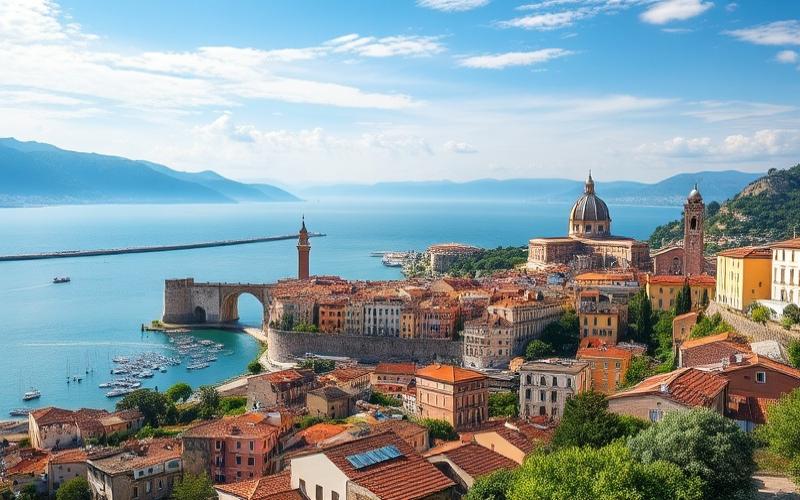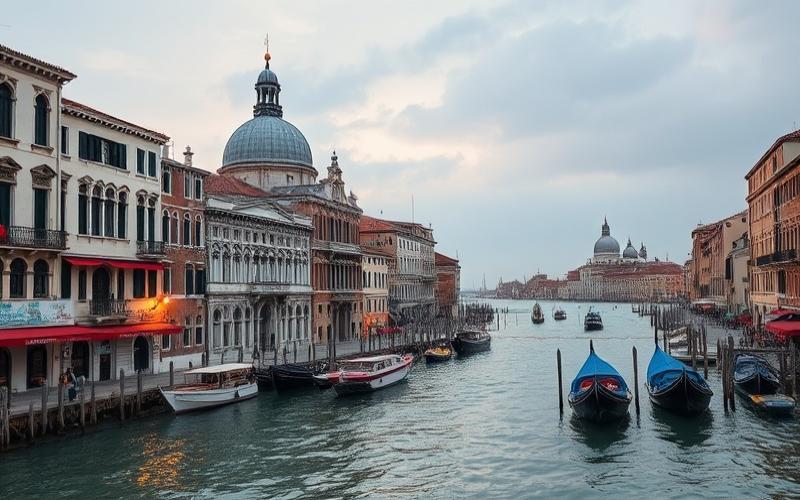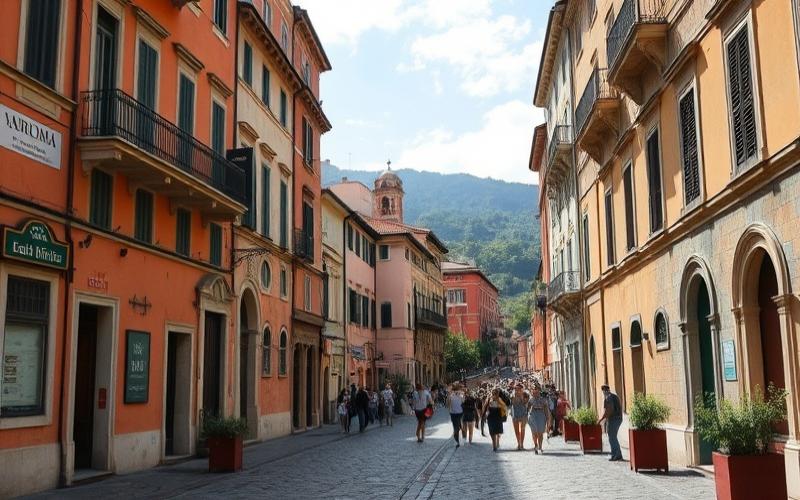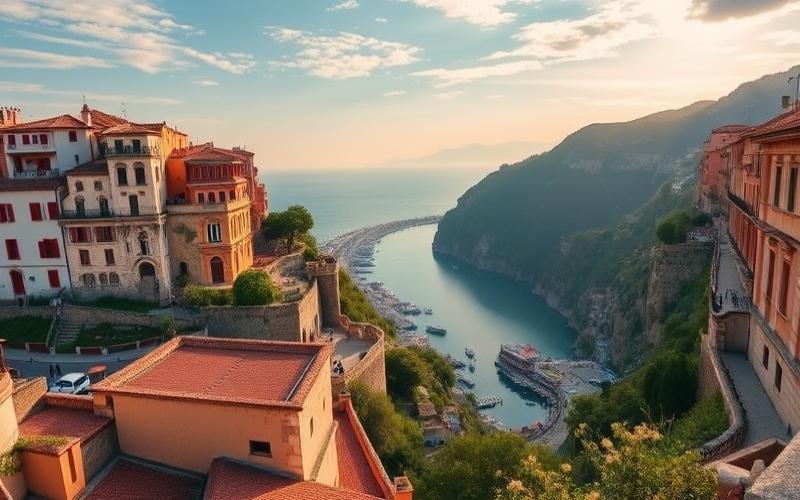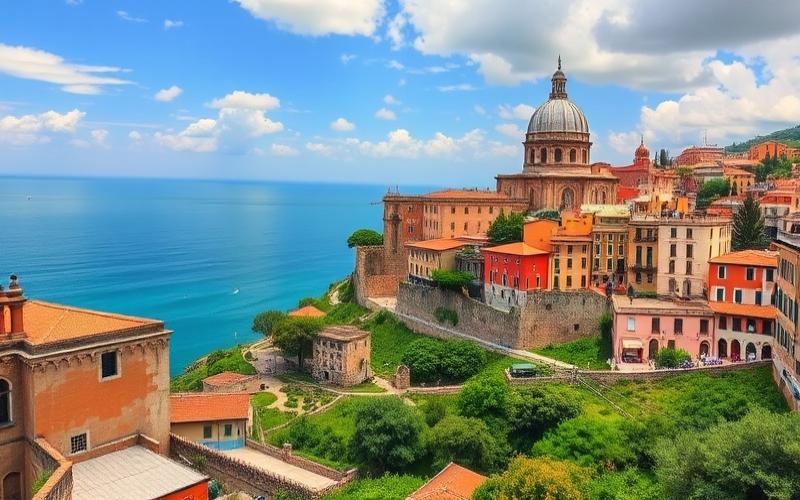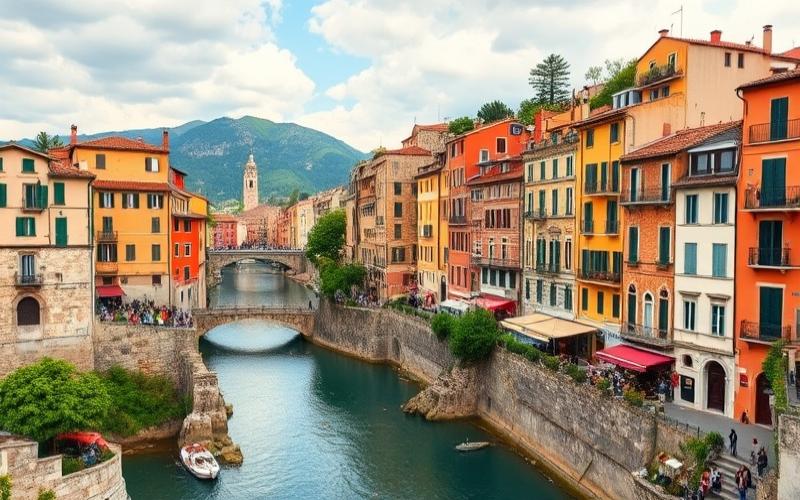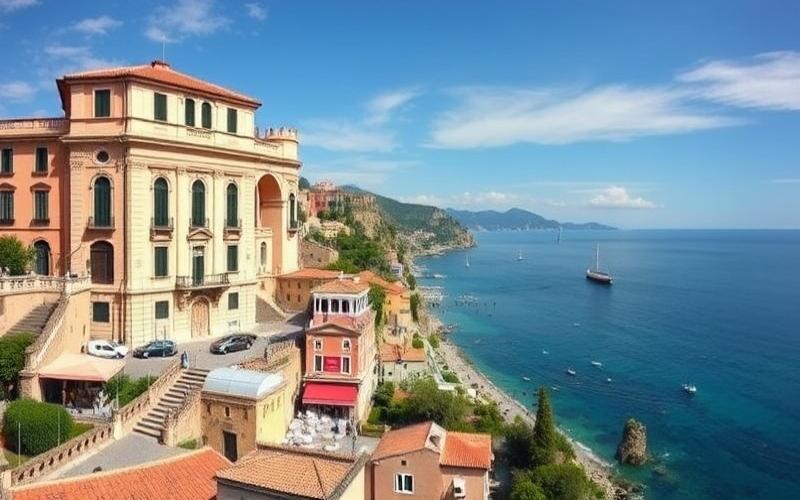
 Published on and written by Cyril Jarnias
Published on and written by Cyril Jarnias
In an ever-evolving real estate market, investing in parking facilities in Italy has become an attractive alternative for investors seeking to diversify their portfolios. With growing demand for parking spaces due to urbanization and flourishing tourism, this niche offers promising prospects.
Indeed, the average return on parking facilities can surpass that of other traditional investments, while requiring less daily management. This type of investment, still under the radar, offers profitable growth potential in a country where conventional real estate opportunities are often inaccessible or saturated.
Profitability and Market Dynamics
Let’s examine together the factors of profitability and the dynamics that make parking facilities in Italy a strategic choice for savvy investors.
Analyzing the Profitability of Parking Facilities in Italy
Urban parking facilities in Italy show profitability heavily dependent on the city, type of asset (surface vs. underground), tourist seasonality, and local mobility policies; hourly/daily rates typically range from €1–2/hour in medium-sized cities to €3–5/hour in city centers, with daily packages from €12–35, and significantly higher occupancy during peak tourist season and major events. In the short term, demand remains strong in tourist hubs and metropolitan areas; in the medium term, profitability is driven by urbanization and tourism but modulated by ZTL/Area C, anti-pollution policies, and competition from shared mobility.
Observed Parking Rates (City Sample)
- Milan
- Paid areas outside hypercenter: ~€2/hour (blue zones); underground: €3.5–5/hour; daily package: €25–35.
- Area C (historic center): entry ticket €7.50 (or €4.50 via affiliated parking), capped hourly rate €4/hour.
- Rome
- 24/7 parking: €2.30–3/hour; packages €8–30/day depending on location.
- Green belt 2025 (metro line A connected parking): €13/day car (€7/day motorcycle).
- La Spezia (Cinque Terre)
- Train station: €1.50/hour (8 AM–8 PM), then €1/hour; central spots: €0.50–2/hour; typical day €20–24 for parking near center/waterfront.
- Alberobello (tourist site)
- Zone B (tourist): €2/hour, public daily subscription €6; private parking: €6 day / €4 night / €10 24 hours; extended paid hours in summer (until midnight).
Occupancy Rates and Seasonality
- Cities with high tourist pressure (Rome, Milan, Cinque Terre, Alberobello): higher occupancy on weekends and during peak season (spring–summer), with frequent saturation of parking near centers/stations/coast in summer.
- Local events (trade shows, festivals, matches) in Milan/Rome increase peak occupancy and allow for higher pricing in central areas.
- Coastal towns/national parks (Cinque Terre) experience strong summer peaks and off-season lows, hence the interest in dynamic pricing policies/daily rates.
Average Acquisition and Maintenance Costs (Operational Benchmarks)
- Acquisition
- Central underground parking: price per spot generally significantly higher than peripheral surface parking; ZTL/Area C entry tickets influence location value and willingness to pay.
- Surface parking in secondary tourist areas: lower capex, but dependency on seasonality and pedestrian accessibility to sites.
- Maintenance/operation
- Recurring costs: security/video surveillance, access control, equipment maintenance, 24/7 lighting, cleaning, insurance; higher costs for covered/underground structures than surface parking.
- Regulatory compliance in ZTL/green belt (signage, license plate control, ticketing integration) and environmental adaptation (e.g., diesel restrictions, LPG exemptions) impact opex.
Economic Factors Influencing Profitability
- Urbanization and density: business centers and ZTL/Area C zones support prices of €3–5/hour and daily rates of €25–35 in Milan.
- Tourism: internationally frequented destinations (Rome, Cinque Terre, Alberobello) maintain high hourly/daily rates and extend paid hours in summer.
- Regulation and mobility: anti-pollution policies (e.g., Rome’s green belt), center access tickets, metro availability/intermodality condition demand and willingness to pay.
- Events and seasonality: increase turnover and revenue per spot; need for yield management.
- Competition: enhanced public transport, ride-sharing/car-sharing, and park & ride influence peripheral pricing.
Profitability Forecasts
- Short term (12 months)
- In major cities and tourist sites, high occupancy rates maintained during peak season; firm pricing in centers (€2.5–5/hour; €20–35/day) and strong performance of subscriptions/daily packages near transport hubs.
- Positive effect of access constraints (ZTL/Area C) on well-positioned assets; sensitivity to weather and event calendar.
- Medium term (2–3 years)
- Demand supported by international tourism and urban growth; adaptation required to environmental standards (diesel, LPG) and integration with public transport to preserve margins.
- Focus on digitalization (online booking, cashless payment) and dynamic pricing to capture peaks and smooth seasonal lows.
Comparison with Other European Markets
Italian central pricing levels (Milan/Rome: ~€3–5/hour, €20–35/day) are comparable to major Southern/Western European cities, but below top-tier Northern European cities (where very dense centers can exceed these hourly/daily rates). Medium-sized Italian cities (La Spezia, heritage destinations) remain cheaper than Northern European capitals, with more tourist seasonality.
| City/area | Typical hourly rate | Daily package | Specific factors impacting demand |
|---|---|---|---|
| Milan (center/Area C) | Up to €4/hour | €25–35 | €7.50 ticket for center access; high prices in hypercenter |
| Milan (outside hypercenter) | ~€2/hour | €25–35 (affiliated parking) | Blue zones; underground €3.5–5/hour |
| Rome (centers/24/7 parking) | €2.30–3/hour | €8–30/day | Strong variation by location and security |
| Rome (green belt) | — | €13/day (car) | Vehicle restrictions; metro line A connection |
| La Spezia (Cinque Terre) | €0.5–2/hour (station: €1.5/hour) | €20–24/day (center/waterfront) | Summer peak; 24/7 parking near ferry terminal |
| Alberobello (tourist) | €2/hour (Zone B) | €6–10 (public/private) | Extended paid hours in summer; marked tourist flows |
Checklists for a Parking Business Plan in Italy
- Location and pedestrian accessibility to hubs (stations, metro, UNESCO sites).
- ZTL/Area C/green belt analysis and vehicle constraints (diesel, gasoline, LPG).
- Rate segmentation: hourly, daily, nightly, event-based; ability to implement dynamic pricing.
- Subscription/daily/event mix to smooth seasonality.
- Opex: security, equipment maintenance, energy, insurance, ticketing; differentiation surface vs. underground.
- Public transport partnerships and booking platforms to capture peak demand.
Useful Key Data
- Milan hypercenter: up to €4/hour; Area C ticket €7.50 (€4.50 in affiliated parking); daily €25–35.
- Rome: €2.30–3/hour; €8–30/day depending on location; green belt: €13/day car.
- Cinque Terre (La Spezia): €0.50–2/hour; daily €20–24; summer peak.
- Alberobello: €2/hour Zone B; €6–10 per day depending on public/private; extended paid hours in summer.
Good to know:
To analyze the profitability of parking facilities in Italy, it’s essential to consider average acquisition costs ranging between €15,000 and €50,000 depending on location, with annual maintenance costs around €1,000. Parking rates differ from city to city, with prices ranging from €1 per hour in cities like Naples to €4 in Rome. Occupancy rates reach up to 90% during summer in tourist cities like Florence but can fluctuate due to local events or tourist season. Rapid urbanization and consistent tourist appeal favor profitability, with stable growth forecasts around 3% in the medium term. Compared to other European countries like Spain and France, profit margins are slightly more attractive in Italy due to lower fixed costs and continuous tourist demand.
Keys to Successful Investment in the Parking Sector
The key success factors for parking investment in Italy rely on prime location, thorough understanding of local regulations (Piani Urbani della Mobilità Sostenibile – PUMS, ZTL, municipal concessions), and digitized operations optimizing occupancy rate and yield management. Adding charging stations and integration with booking platforms increases profitability.
Strategic Locations to Prioritize
- Major metropolitan areas with high parking pressure and extensive ZTL: Milan, Rome, Florence, Bologna, Turin.
- Intermodal hubs: high-speed train stations (Milano Centrale, Roma Termini, Torino Porta Susa), airport hubs (Malpensa, Linate, Fiumicino).
- Historic centers and UNESCO zones with limited public supply and high pricing.
- Tourist and coastal destinations with marked seasonality: Venice/Mestre, Cinque Terre/La Spezia, Amalfi Coast, Sardinia, Sicily (Palermo, Catania).
- University and hospital hubs: Padua, Pisa, Bologna, Naples, where recurring daily demand is strong.
- Business parks and new mixed-use districts subject to road reduction policies and parking space quotas.
- Medium-sized cities with logistic/industrial growth in the North (Veneto, Lombardy, Emilia-Romagna) for long-term mix (subscriptions) and rotating demand.
Value Creation Factors and Operational KPIs
- Target occupancy rate: 75–90% on weekdays, with dynamic pricing during peaks (events, weekends).
- Revenue per spot: maximized via segmentation (rotating, subscribers, corporate, residents), bundles and overnight rates.
- Product mix: standard spots + EV charging + secured motorcycles + premium boxes.
- Costs: access automation (LPR/ANPR), frictionless payment, predictive maintenance to reduce OPEX.
- Partnerships: local operators for daily management and tech companies for distribution and IoT.
Specific Regulatory Framework in Italy Impacting Opening and Operation
- Primarily municipal jurisdiction: permits, service concessions and specifications vary by municipality.
- ZTL and PUMS: favor discouraging on-street parking in favor of structured parking in periphery/intermediate rings, with shuttles or public transport integration.
- Technical and safety standards: fire safety requirements, accessibility for disabled persons, ventilation, video surveillance, signage and bike/motorcycle quotas according to local plans.
- Urban planning and heritage: archaeological and landscape constraints in historic centers; sometimes possible exemptions for underground parking with architectural integration.
- Sustainable mobility policies: parking space caps in new developments, obligations to equip with charging infrastructure, incentives for “smart” management to reduce search traffic.
Tax Incentives and Potential Schemes
- Depreciation of technological equipment and charging stations.
- Possible municipal bonuses/discounts in tenders for park & ride or projects integrated with public mobility.
- Preferential pricing or co-financing for smart parking solutions and sensors aimed at reducing congestion and emissions.
- Occasional regional schemes for rehabilitation of existing infrastructure and energy/safety upgrades.
Market Trends and Impacts of Urbanization and Sustainable Policies
- Sustained urbanization and service sector growth in the North favoring structured demand off-street.
- Reduction of surface parking, rising on-street rates and ZTL extension increasing demand for well-located private parking.
- Growth of electromobility: monetization via charging, but need for power management (load balancing) and adapted pricing.
- Accelerated digitalization: real-time booking, interoperability with MaaS, mobile payments, and dynamic pricing.
- More volatile tourist seasons: need for pricing algorithms and alliances with hotels/OTAs.
Recommended Partnerships to Maximize Profitability
- Local parking operators for daily management, compliance and relations with municipalities.
- Technology companies: ANPR/LPR, occupancy sensors, booking and payment platforms, energy optimization for EV.
- Mobility players: public transport (Park & Ride ticketing integration), MaaS, car-sharing and micromobility to increase flow and attractiveness.
- Utilities/ESCos for financing and operation of charging stations (energy performance contracts, revenue sharing).
- B2B corporate partnerships for guaranteed subscriptions (companies, hospitals, universities).
Location and Strategy Prioritization Table
| Zone | Investment thesis | Target product | Key risks | Mitigation levers |
|---|---|---|---|---|
| Metropolitan ZTL (Milan, Rome, Florence) | Captive demand off-street, high rates | Multi-level underground + EV + ANPR | Competition, heritage constraints | Yield management, heritage design, municipal agreements |
| Intermodal hubs (stations/airports) | High turnover, predictable flow | Rotating + reservation | Flow dependency, high CAPEX | Contracts with transport operators, dynamic pricing |
| Historic tourist centers | Premium seasonal | Box/valet + EV | Seasonality, strict regulation | Hotel partnerships, event pricing |
| Medium-sized Northern cities | Subscription stability | Subscriptions + corporate | Moderate growth | B2B contracts, motorcycle/car mix |
| University/hospital hubs | Recurring demand | Subscriptions + extended hours | Price sensitivity | Differentiated rates, packages |
Best Execution Practices
- Conduct micro-local study: pedestrian/car flows, competition, price elasticity, municipal policies.
- Pre-integrate technological architecture: LPR, distribution APIs, cybersecurity, EV modularity.
- Structure hybrid revenues: DOOH advertising, lockers, nighttime urban logistics services.
- Plan performance contracts with SLAs and bonus-malus on service quality.
- Implement indicators: RevPAR per spot, booking conversion rate, customer acquisition cost, charger availability, OPEX/spot.
Good to know:
To succeed in parking sector investment in Italy, it’s crucial to target strategic locations, particularly in major cities like Milan, Rome, or Florence, where parking demand is high due to growing urbanization. Investors must be aware of strict zoning regulations and permit processes that can vary by region, thus influencing project feasibility. Italy sometimes offers tax incentives to promote urban infrastructure, which can be advantageous for reducing initial investment costs. Furthermore, partnerships with local operators and technology companies are essential to optimize parking management through innovative solutions like online booking systems and mobile payment applications, which meet new consumer expectations and strengthen investment profitability.
Market Study: The Potential of Parking Facilities in Italy
The potential of parking facilities in Italy is supported by densification of major cities, tourist pressure and public policies that reorient urban space usage, creating both constraints for on-street parking and opportunities for structured, technological solutions.
- Major Italian metropolitan areas display critical mass and moderate but positive demographic growth, with Rome leading (~2.75M inhabitants) ahead of Milan and Naples, supporting sustained urban mobility demand and organized parking.
- 2025-2030 real estate market projections indicate reinforced attractiveness of urban hubs (Milan, Rome), with rising prices and rents, signaling land use tension and stricter trade-offs between residential, service sector and parking spaces.
- Tourism growth in 2025 (+17.9% summer) and major events (Jubilee Year in Rome) increase seasonal pressure on parking, particularly in historic centers and near multimodal hubs.
- Italian municipalities strengthen decongestion measures (prioritizing public transport, calming centers, progressive restrictions), limiting surface parking and favoring structured parking in periphery or intermodal P+R.
- National and local policies promote alternative mobility (transit, walking, cycling) and more sustainable urban experiences, redirecting demand toward managed parking solutions, dynamically priced and integrated with transport offerings.
- Real estate prospects until 2030, driven by infrastructure investments, support urban regeneration projects likely to include modernized, multi-use parking capacities.
- Italian users show growing preference for digital booking, security (video surveillance, access control) and proximity to activity hubs; willingness to pay increases for premium services (charging stations, guarded parking, availability guarantees).
- Rising rental prices and mobility costs push toward seeking packaged offers (subscriptions, resident overnight rates, event offers), with reinforced price-quality sensitivity in 2025.
- Tourist pressure increases demand for flexible solutions (dynamic hourly pricing, pre-payment for attractions/historic centers), particularly in Rome and Venice, with attention to sustainability and reduced search time.
- Compared to other mature European urban markets (e.g., dense historic centers), Italian cities combine constrained urban heritage and high tourist flows, bringing their profile closer to destinations with high seasonality and restrictive circulation policies.
- Italy’s most attractive investment hubs (Milan, Rome, Naples, Turin, Bologna, Florence) offer growth trajectory comparable to Southern European regional capitals, with premium for operated and technological assets (smart parking, EV-ready).
- Modernization gap compared to some Northern European markets creates potential catch-up via digitalization, sensors and MaaS integration, with potential for mobility data monetization and proximity services.
| Axis | Implications for parking | Key indicators |
|---|---|---|
| Urbanization and tourism | Increased demand for managed capacities near centers and intermodal hubs | Urban population growth, seasonal peaks |
| Public policies | Decline in surface parking, rise of P+R and multimodality | Calming measures, major events |
| Customer preferences | Payment for security, booking, charging, spot guarantee | Rising rental prices, value seeking |
| European comparables | Heritage constraint + tourism = need for smart solutions | Attractiveness of major Italian cities |
- Market is fragmented between structured parking operators, booking platforms and real estate players, with investment concentration in leading cities (Milan, Rome, Naples).
- Cities highlighted for investment in 2025 (Milan, Rome, Naples, Turin, Bologna, Florence, Bari) signal priority corridors for development and optimization of parking assets.
- Favorable real estate dynamics (lower mortgage rates, infrastructure projects) reinforce bankability of modernization and extension projects, particularly EV-ready and oriented toward event/tourism flows.
- Possible partnerships with local authorities for P+R, office-residential-event sharing, and integration with transport tickets (MaaS).
- Technological innovation: occupancy sensors, dynamic pricing, real-time booking, ANPR, frictionless payments, and electric charging hubs aligned with energy transition.
- Alliances with digital platforms and mobility operators (car-sharing, micromobility) to package combined offers, reduce spot search and streamline tourist and commuter flows.
Italian cities with high density and high tourist traffic, combined with decongestion policies and customer demand oriented toward security and digitalization, create favorable ground for structured, intermodal and technologically advanced parking facilities, with growth potential concentrated in Milan, Rome and Naples.
Good to know:
Growing urbanization and demographic increase in Italian cities like Rome, Milan, and Naples foreshadow increased demand for parking spaces, although local policies seeking to reduce congestion and promote alternative transport should be monitored. Italian consumers, eager for secure solutions and complementary services, are willing to pay extra, so competitive analysis reveals opportunities for technological partnerships to stand out. Compared to other European markets, Italy offers definite potential for innovation in the parking sector, despite current competition dominated by a few key players.
Comparing Parking Spot Yields in Italy
Parking spot yields in Italy vary by city and micro-locations, with generally observed ranges around 5–10% gross depending on location and type (open spot vs box), but with significant gaps between historic centers and peripheries.
- In Rome, demand is driven by urban density, scarcity of on-street parking and ZTL presence. Central locations (Tridente, Prati, Trastevere) show high rents but very high purchase prices, often compressing yields toward lower range (≈5–6% gross typical), while well-connected peri-central neighborhoods (San Giovanni, Ostiense) and covered parking near service sector hubs can reach ≈6–8% depending on local supply.
- In Milan, demand pressure is strong around center and service sector hubs (Porta Nuova, CityLife), but acquisition cost is among highest in country, pulling yields toward 4–6% in hypercenter and 6–8% in well-connected residential areas (Navigli, Città Studi), with higher potential for secured boxes or EV-equipped spots.
- In Naples, formal supply is limited in dense neighborhoods (Chiaia, Vomero, Centro Storico), local demand is sustained and purchase prices comparatively more accessible than Rome/Milan, frequently allowing gross yields in upper range (≈7–10%) depending on security and accessibility.
- In Turin, dynamics are intermediate: purchase prices are more moderate and demand solid near universities, hospitals and industrial/service hubs. Observable yields tend toward 6–8% for well-located spots, with peaks in peri-urban areas where entry ticket is low and vacancy controlled.
Key Factors Influencing These Yields:
- Local demand: density, ZTL, surface parking saturation, metro/station proximity, service sector hubs, universities and hospitals increase occupancy and rents.
- Initial purchase cost: high prices in Rome/Milan centers compress yields; lower tickets in Naples/Turin/peripheries improve rent/price ratio.
- Maintenance fees: low vs housing (few repairs, limited charges), supporting net profitability; closed, secured box can justify higher rent with modest additional costs.
- Local taxes and charges: property tax/condo fees generally lower than housing, improving net margin; land regime or LMNP possible depending on setup.
Comparative Table (Indicative order, usual gross ranges by micro-location and spot/box type):
| City | Gross yield center | Gross yield peri-urban | Demand drivers | Main constraints |
|---|---|---|---|---|
| Rome | ≈5–6% | ≈6–8% | ZTL, scarcity, tourism, service sector hubs | High purchase prices compressing yield |
| Milan | ≈4–6% | ≈6–8% | CBD, offices, road restrictions | Very high acquisition cost |
| Naples | ≈6–8% | ≈7–10% | Density, saturated roads | Supply/formality heterogeneity |
| Turin | ≈5–7% | ≈6–8% | Universities, hospitals, industry | Demand more segmented by neighborhood |
Concrete Examples Center vs Peri-urban:
- A secured box near service sector hub or urban station in Rome/Milan can rent significantly higher than open spot, but high purchase price often limits yield to ≈5–6% in center.
- In well-connected peri-urban (park & ride or near local metro/RER), purchase at lower ticket allows reaching 7–8% on standardized spots, even more if residential parking supply is constrained.
- Adding EV charging station and access control can increase rent and occupancy, particularly in neighborhoods where on-street charging is rare, improving net profitability.
Recent Statistics and Benchmarks:
- Parking spots often show gross profitability of 6–10% when entry ticket remains contained and fees limited, higher than housing with comparable characteristics.
- In 2025, parking facilities are driven by urban space scarcity and needs for secured (EV) parking, with ranges of 5–10% depending on location and condition.
- Italian real estate market 2025 shows transaction recovery (e.g., Turin +12.2% Q1 2025), signal of appetite and activity, even if rental investment remains minority; higher liquidity improves potential exit of niche assets like parking.
Current Trends in Italian Parking Market:
- Rising EV needs: increased demand for equipped charging spots, rent premium and better occupancy expected in major cities.
- Urban regulatory pressure: ZTL, reduction of on-street spots and decarbonation policies support value of private parking in center and peri-center.
- Simplified management and contained costs: few structural capex/opex, stabilizing net profitability vs other real estate asset classes.
- Improving liquidity: residential transaction recovery in Rome/Milan/Turin favors ecosystem and ancillary asset arbitrage, including parking.
Projections and Possible Evolutions:
- Short term (12–24 months): maintenance of gross yields near 5–6% in Rome/Milan hypercenters and 6–8% in Naples/Turin/well-served peripheries, with outperformance of secured boxes and EV-equipped spots.
- Medium term (3–5 years): if municipalities continue reducing surface parking and extending ZTL, rents for well-located private spots could experience upward pressure, partially offset by potential purchase price increases; yield could thus remain stable or slightly compressed in centers, and more resilient in connected periphery.
- Risk/opportunity: acceleration of shared parking supply or public infrastructure can temper rents locally; conversely, rise of shared fleets and two-wheelers could shift demand toward versatile boxes (storage + micro-mobility + charging), supporting rental values.
Points to Consider Before Investing:
- Check sector occupancy rate, ZTL presence, competition (public lots, retail, hospitals), and precise charges/taxes of condominium.
- Prioritize locations with secure access and EV options, and calibrate rent to local market to minimize vacancy.
- Consider liquidity upon resale according to city/neighborhood, in line with transactional dynamics observed in 2025.
Good to know:
Parking yields in Italy vary considerably by city: in Rome and Milan, average yields are around 5-6% due to high demand despite high initial purchase costs, while in Naples and Turin, yields are closer to 4-5%, influenced by lower costs but more fluctuating demand. Key factors include parking positioning, acquisition cost, and recurring charges like maintenance fees and local taxes, which can differ significantly between urban and peri-urban areas. Recent data shows an upward trend in demand in metropolitan areas due to increasing vehicle numbers, which could lead to rising prices and yields in coming years. Furthermore, local sustainable mobility initiatives also influence the market, potentially either limiting availability of new spots or favoring alternative parking models like spot sharing.
Disclaimer: The information provided on this website is for informational purposes only and does not constitute financial, legal, or professional advice. We encourage you to consult qualified experts before making any investment, real estate, or expatriation decisions. Although we strive to maintain up-to-date and accurate information, we do not guarantee the completeness, accuracy, or timeliness of the proposed content. As investment and expatriation involve risks, we disclaim any liability for potential losses or damages arising from the use of this site. Your use of this site confirms your acceptance of these terms and your understanding of the associated risks.






